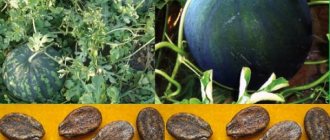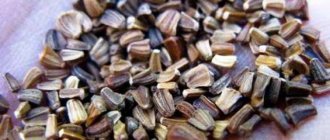Making a square shape with your own hands
Don't waste money on a mold for growing watermelons, but create one yourself. To do this you will need the following tools and materials:
- main material of the box (polycarbonate, plexiglass or plywood) – 1 sheet (panel) with an approximate thickness of 12 mm;
- a metal corner with a width of at least 30 mm;
- door hinges – 4 pcs.;
- door latches – 2 pcs.;
- fastening elements – bolts with nuts, self-tapping screws;
- jigsaw;
- drill;
- screwdriver;
- feather drill with a diameter of 0.25 cm.
Container creation process:
- Cut 6 blanks from the main material of the box. At the same time, make one with dimensions of 25 × 25 cm, and the others a little larger. In this case, the diagonal of the container must be wider than the diagonal of the watermelon itself, otherwise it will not fit.
- Prepare the workpieces for assembly. On the workpiece that will be the top cover, drill a 2.5 cm hole. From it to the edge, cut a strip about 2 cm wide.
- Assemble the structure. Attach 2 door hinges to the side wall and lid. In this case, the ends of the walls on the sides should be covered with a lid. Next, connect the blanks with self-tapping screws with protruding caps. If necessary, reinforce the box joints with metal corners.
- Make the finishing touches. Attach the 2 remaining door hinges to the bottom of the frame to create a second door. It will be needed when removing the fruit from the mold. Place locks on both doors. And in the corners of the structure, cut several small ventilation holes. For better heat perception, make the box black or transparent.
Sequence of manufacturing the structure
- First, prepare 6 square sheets of 20x20 cm from the material.
- Using fasteners, connect the sides of the cube.
- Then the lid is made. A circle with a diameter of 25 cm is drilled in the center of the square. Starting from points of the circle opposite in diameter, parallel lines are drawn to one of the sides of the lid. After making the cut, a wide gap is left.
- The lid and bottom plane of the cube are attached using rotary hinges. They are equipped with loops with a fastener.
- From an aluminum corner cut into 4 parts you will receive additional fasteners for fixing the walls of the mold.
Buying a ready-made form is quite difficult. The designs are sold in specialized stores in large cities. The number of form copies will be small. If you decide to make square watermelon production part of your business, you will need to specially order molds.
Pros and cons of growing unusual fruits
Square watermelons have certain advantages over round ones:
- low risk of fruit damage during transportation;
- the possibility of compact arrangement of berries during their storage;
- convenient form for cutting portions;
- long shelf life - as some sources say, such a watermelon can be stored for about a year without spoiling.
But this culture also has the following disadvantages:
- unripeness of fruits associated with the berries being in a container for shaping;
- the risk of being damaged upon contact with the container - if it is too tight, the berry, as it grows, becomes deformed;
- decreased taste.
Where to buy a square watermelon
Initially, the cultivation of square berries was carried out only in Japan , so such a product was found only on local agricultural lands and by pre-order. Now domestic farmers have learned to annually grow such a quantity of unusual watermelons that will satisfy the demands of the entire Russian market.
Square fruits appear on supermarket shelves even in the depths of winter . The opportunity to enjoy juicy and sweet pulp is given to consumers by owners of greenhouses from foreign countries, where climatic conditions are favorable for harvesting almost all year round.
Features of cultivation
In order for square-shaped watermelons to delight you with their harvest, you need to choose the right place to plant them. It should be sunny and unshaded. This melon crop does not like shade. The soil should be structured, rich in microelements and non-acidic.
If the soil does not meet these requirements, mix a little lime or wood ash into it. And add sand from the river to light and loose soil while digging.
Do not plant watermelons where other melons, cucumbers and cabbage previously grew. In this case, there is a risk of infecting the seeds with harmful viruses. Grow the crop where peas, potatoes, corn or sunflowers were.
Preparing and planting seeds
Most often, watermelons are grown from seedlings. The essence of this method is that in March the seeds are planted in small cups and after the sprouts appear, they are moved to open ground.
This method is applicable in those regions where the climate does not allow growing melons directly in the open air.
How to grow seedlings:
- soak the seeds for 3 days in a growth stimulator;
- put them in the refrigerator for 2 days;
- sow the prepared seeds in cups with fertile soil;
- cover the seedlings with film.
In order for the seeds to hatch on time and develop normally, water them regularly, ventilate them and maintain their optimal temperature of +25 degrees and above. Do not grow seedlings on a windowsill, as melons do not like temperature fluctuations.
After 1.5 weeks, watermelon sprouts will appear. Plant the crop in open ground at the end of the last spring month - beginning of summer. The seedlings should already have at least 5 leaves. The weather during planting should be warm and sunny. Add humus to the soil before planting.
Caring for seedlings before placing in mold
For the first 2 weeks after planting the sprouts outside, properly care for them:
- regularly water the seedlings with warm water - once a week or once every 3 days if it’s hot;
- cover them at night when the temperature drops;
- systematically loosen the soil and feed the melon with liquid organic fertilizers;
- ventilate the sprouts by lifting the film (if they are covered);
- get rid of emerging weeds;
- mulch the holes with a 10 cm layer of straw.
Growing in a greenhouse
If you live in a cold climate, grow watermelons in a greenhouse. The optimal height of such a greenhouse is approximately 1.7 m. At the same time, grow only melons and melons in it, since watermelons do not like other proximity in a confined space. The humidity in the greenhouse should not exceed 60%, and the temperature should not exceed +30 degrees.
Sow watermelon seeds, not seedlings, into the greenhouse soil. Water the crop regularly and ventilate the greenhouse. Despite the external protection, keep a watermelon cover at the ready in case the temperature drops at night.
When and how to put it in the mold and what to do next?
When the watermelon has grown to the size of a tennis ball (about 6-10 cm in diameter), place it in the container you made to give the fruit a square shape. Do this by threading the watermelon loop through the hole in the box.
What to do after placing the fruit in the container:
- straighten the watermelon so that its stripes are located clearly vertically along its edges;
- also water the crop abundantly;
- Cover the container on top to prevent overheating.
Once the watermelon reaches the size of the container, it will begin to take on its shape. Typically, the ripening period for a crop after planting in the open air is approximately 95-100 days. The main thing is not to miss the moment when the watermelon is already ripe, but not too big. This cannot be allowed, otherwise it will tear the box.
After the berry reaches its ripeness, remove it from the garden bed by twisting the stalk several times and remove it from the box. For a reusable container, simply remove the lid.
It happens that after removal from the container, the watermelon is not bright enough in color. To fix this, leave the berries in the sun for 2-3 days.
When to put in the mold?
After flowering and pollination, small fruits appear in place of the flower. When they reach a diameter of approximately 6-10 cm, they need to be placed inside the prepared mold. To do this, the loop of the vine on which the watermelon is located is carefully threaded through a hole specially designed for this in the wall of the container. In this case, you need to ensure that:
- the fruit was located in the center of the container;
- the stripes on its surface were parallel to the edges.
Depending on weather conditions, plants should be watered regularly and, if necessary, to avoid overheating, cover the boxes with fruits. Having reached the walls of the container, the watermelon will begin to change shape, trying to fill all the internal space. If the size of the box was chosen incorrectly, the fruit may tear it when it becomes too large. At this time, you need to not miss the moment of ripening of the berries. For most varieties, the growing season (between planting and ripening of watermelons) is 95-100 days.
When the berries ripen:
- its stalk dries out;
- when tapping, a muffled sound is heard;
- the surface becomes glossy;
- the crust becomes rigid and does not bend when pressed.
Remove the watermelon from the mold; if the surface is not bright enough, leave the watermelon in the garden without a container for several days.
Harvest and storage
Watermelons can be harvested 95-100 days after they are planted. If you are going to store the fruits for a long time, pick them during the first stage of ripeness. You can cut the fruits with a knife or pruning shears. In this case, leave the tail at least 5 cm long.
Store watermelons on a thin layer of straw in a dark place. Place the berries on racks or in earthen trenches. If the fruit has any damage, it will not be able to be stored for long.
Watch the video below on how to grow, select and store a square watermelon:
Features of storing square berries
Late-ripening square watermelons are grown for long-term storage. After collection, they are laid out in a well-ventilated place on a layer of dry straw. The laying shape is a pyramid of 7-8 rows. Fence the area with fragile goods with boards. Scientists and plant breeders around the world undoubtedly continue to work on the creation of new bizarre forms of plants. The experiments concern many crops - melons, cucumbers, tomatoes, radishes, apples. Cone-shaped watermelons and cucumbers, which have a star-shaped cut rather than a round one, amaze the imagination of consumers.
Article Rating
Reviews from gardeners and consumers
★★★★★
Yuri, 49 years old, builder, Armavir. I tried to grow square watermelons - it didn’t work out very well.
Many of the containers I bought were deformed under the influence of the growth force of the berries, and the watermelons themselves cracked. The shape was still more round than square. Disappointed. ★★★★★
Victoria, 38 years old, manager, Dmitrov. I think that when growing such watermelons, you need to take the most rigid container possible.
For example, glass flasks. In this case, there is a chance that they will withstand the growth of fruits. I tried this watermelon - in principle, the taste is interesting, but for me, it’s a little dry. Hide
Add your review
The secret of the appearance of square watermelons turned out to be quite simple. However, without following the cultivation technology and proper care, an attempt to grow such a fruit on your home plot may not be entirely successful. Consider the climate of your region and be sure to choose a rigid container to create the mold.
0
0
Copy link
The history of the appearance of an unusual shape
Square watermelons first appeared 3 decades ago in Japan. They were grown for ease of transportation, because stacking square fruits on top of one another is much easier than round ones. This saves space and prevents watermelons from breaking. But it turned out that customers liked the unusual product and began to grow it due to good demand. However, there is still not a large scale and square watermelons in Japan are mainly grown to order.
Preparing and planting seeds
Watermelon seeds are planted at the beginning of summer, sometimes in May, when the weather is warm. Experienced melon growers who know well how to grow watermelons understand that a lot depends on the quality of the seeds. Take seed material zoned for early ripening in your area. Before planting, specially treat:
- Warm up for 10 days (create a temperature for dry seeds of about 55 degrees - calcination in the sun). You can simply warm up the seeds near the radiator in February.
- Soak the seeds in water for half an hour and remove any that float.
- After this, pour hot water at 50-60 degrees into the bowl with the seeds and leave until it cools. Drain this water and pour in new water for biting.
- 3 days before sowing, soak the ash in water in a ratio of 1:2, respectively, leave for half a day, stirring.
- Dip the seeds in a dark solution of potassium permanganate, rinse, and soak overnight in the prepared ash solution.
When sowing, focus on a soil temperature of 15 degrees above zero. The soil should be loose and fertile. Sow 10 seeds per linear meter to a depth of 6-8 cm (not all will sprout). If low temperatures prevent you from sowing a crop in a timely manner, you must first germinate the seeds in a peat pot. During this time the earth will warm up. When the temperature changes, a square watermelon is grown in a greenhouse.
The advantage of this shape of watermelon and the difference from the round one
Everyone is accustomed to the fact that watermelon is a round berry or, in extreme cases, oval. But in the last few years, you can see cubic watermelons on the market. According to the characteristics, this is the same berry, only of a different shape. There are no differences between cubic and round berries, except for the shape.
Square watermelons have been around for several years. For the first time, the Japanese managed to give the fruit a square shape. The advantages of such berries are that in this form the fruits are easier to transport. They take up less space during transport. This is the only advantage of square watermelons compared to round ones.
Black, noble and most expensive
One of the first specimens of a black watermelon of the Japanese Densuke variety, the most expensive of all, was bought at auction for more than $6,000.
The buyer stated that he was driven by the desire to strengthen the agriculture of his country. The fact is that Japanese breeders bred an unusual fruit specifically to support local rice farmers when they began to suffer losses in the 80s. The name of the variety roughly translates to “helping rice fields.” It was subsequently sold for two to three hundred dollars, and today its value is about $50.
The photo shows a black watermelon of the Densuke variety.
What is unusual about the Densuke variety? The absolutely black, noble color rind is combined with very bright flesh. The variety is very rare, grown in the only place in the world, on the island of Hokkaido. Those who were lucky enough to experience the taste of the exclusive watermelon call it “unprecedented”; in any case, the sugar content is very high, and the pulp is pleasantly crunchy. It goes on sale in branded packaging - in beautiful black boxes and is sold, of course, only in elite stores.
How to make a polycarbonate cube for melons
The process of making a plastic cube looks like this:
- Take one of the polycarbonate sheets. Using a drill or hole saw, drill a hole 2.5 cm in diameter.
- Using a hand hacksaw or jigsaw, make 2 cuts in the direction from the hole to one of the edges of the sheet. Remove the cut piece. This is the hole for the watermelon tail.
- Now make the side. Attach it to the lid, blocking the end. Connect both sheets with gate loops.
- Do the same on the opposite side.
- The two remaining side inserts need to be adjusted in size so that they fit snugly into the remaining openings. Accurately measure the length and width, if necessary, file.
- Use a drill to make pilot holes in the sides so that they go deep into the ends of the inserts (at least two in each). Screw screws into the holes.
Advice. If the plastic sheets are thin, then the screws can be replaced with corners. But in this case, fix them very firmly, since under pressure the walls of such a box can bulge out from the inside and become rounded. Because of this, a watermelon cube will not work.
The final stage of manufacturing the box is to install the bottom. You need to cut it according to the insertion principle, adjusting the size. The principle of fastening is similar to the lid (hinges). All loops should be secured with buckles. Place the latter opposite each loop. Finally, make sure that the finished form lets in not only light, but also air. Otherwise, the vegetable may rot.
Any variety of watermelon can be given an unusual shape.
How to determine the degree of ripeness of fruits
A ripe watermelon has a rich red-pink color inside, juicy, sweet, with dark seeds. However, it is very important to determine the degree of ripeness of the berry before it is cut.
- peel color is shiny, glossy;
- the crust is dense, durable, and cannot be pressed with a finger;
- the stalk is dry;
- a yellow bedsore forms at the point where the berry comes into contact with the soil;
- When tapping, a dull sound is heard.
When cut, the watermelon cracks and juice releases.
How to do it correctly
The technology has not changed since its invention: the growing “ball” is placed in a box made of thick (about 8 mm) transparent polycarbonate.
Container size: 20x20 cm. A watermelon is placed in such a “dungeon” when it grows to the size of an apple. The top of such a box must have ventilation holes that will protect the fruit from rot. Also don't forget about the hole for the ponytail.
This is what this form looks like:
To make it, you need: 6 pieces of polycarbonate, 2 hinges with buckles, 4 so-called gate hinges, screws (thin, from 25 to 40 mm), nuts, washers and screws, as well as a metal corner to strengthen the walls of the mold.
As for tools, you should have: a hole saw, a drill, a hacksaw (for metal, for corners), a screwdriver and a jigsaw.
Important points:
- Melons need a warm climate (such as in the south of Russia or in the Ukrainian Kherson).
- Choose fast-growing varieties (it has been noticed that in the South, varieties adapted to the middle zone grow especially gratefully - like by leaps and bounds).
- True, fast varieties need to be sold quickly, they are not stored for a long time - if you plan to transport and store your harvest for a long time, grow late-ripening varieties.
- If your climate in May has large differences between night and day temperatures, it is better to grow this crop in a greenhouse.
- You can grow such a miracle both from seeds and by seedlings (the latter has proven itself well in central Russia).
The correct temperature for this crop: from 25 degrees during the day and not lower than 17 at night.
Basic rules for growing watermelons
- Seeds or seedlings are planted in open ground at the end of May or early June, leaving a meter between future bushes.
- The bed should be fertilized with manure.
- Watermelons will be grateful for watering. But do not connect the hose directly to the well; this crop does not like ice water. It’s better to fill a large vat, let the water warm up in the sun all day, and in the late afternoon distribute the water with a watering can. Yes, it is long and difficult, but you will be able to harvest a tasty and nitrate-free harvest. You definitely can’t buy this in a store!
By the way, watering is stopped halfway through the ripening period.
If everything went well, each vine can produce 4-7 flowers. Experienced gardeners advise plucking off the weakest ones, leaving 4 high-quality flowers.
Watermelon flowering begins approximately 35 days after planting.
The fruit will ripen somewhere on the 100th day after planting, but early ripening varieties can please you even on the 65th day.
How to grow cube fruit yourself
It is recommended to grow cubic watermelons in the southern regions, which are most suitable for this plant in terms of climatic conditions. If you decide to grow such a fruit yourself, then the first thing you need to do is decide on the plant variety. Now there are varieties climatically adapted to colder territories, but, nevertheless, watermelons in the middle zone rarely have time to grow large enough to allow them to form themselves into a cubic shape.
Once the plant variety has been selected, the next step will be planting the seedlings. This must be done in early May, otherwise the fruits will not have time to grow and there will be practically no chance of getting a decent harvest.
Tips for caring for berries
Proper care of this berry will help you achieve a good harvest when it comes to watermelon. After the first leaves appear, you need to start loosening the soil regularly. It is also important to ensure that the fetus is always dry and warm.
Equal attention is paid to the form itself. If it is too large for the ripening fruit, then it will not be possible to get a square.
And if, on the contrary, it is small, then the watermelon may crack before it ripens.
Subtleties of watermelon care
If there are rainy days, then the berries must be covered. When the fruits reach a size of about ten centimeters in diameter, then you need to pinch the main loop of the shoots, and it is better to remove their side part.
This will allow the fetus to retain strength, which will go towards the formation of the main ovary. And it is at such a moment that the fruit should be placed in a form specially prepared for it. Subsequently, you need to promptly remove weeds and weak ovaries around. Molds need to be ventilated every few days. And also cover it when the sun is hot.
See also
Description and characteristics of watermelon variety Sugar Baby, cultivation
Read
Fertilizing berries
During the ripening stages, watermelon should be fed. For this purpose, mineral fertilizers are used, which must contain the following components:
- nitrogen;
- phosphorus;
- potassium and calcium;
- magnesium.
The soil around the hole is treated with fertilizer, which is pre-moistened and loosened.
Irrigation scheme
This berry needs to be watered sparingly. And this is the main point that is important to follow. She loves dryness and does not tolerate waterlogging, so overwatering will negatively affect the harvest itself. Water cannot be poured into the hole itself. The area of land around it should be watered.
Diseases and pests
Square watermelon is one of those crops that are susceptible to pathogenic fungi and bacteria, as well as attack by pests. It is important to inspect the fruits in time.
Regular ventilation can be preventative. Disinfection is also used. The forms can be fumigated with a sulfur bomb, and the soil itself near the hole must be watered with hot water, with the addition of a manganese solution.
Price policy
No more than 100 units of this cubic exotic are imported to Russia annually. The cost of one watermelon on the Russian market sometimes reaches $500 per piece, so the average domestic buyer does not show much interest in it.
And in general, given such a high price and low taste, the melon miracle is not so often popular. But despite the factors that do not speak in its favor, the demand remains at the same level and it continues to be actively used as a decorative and non-standard decoration for various celebrations.
Advantages and disadvantages
The internal contents of a watermelon are no different from the standard shaped mouth of berries. True, they may be inferior in taste standards. But such berries have a number of distinctive features:
- convenient to store and transport, minimizing transportation costs;
- convenient to place on the dining table and in the refrigerator;
- square shape facilitates accurate cutting;
- high cost on the market.
But the transformation affected only the external forms of the berry and did not affect the taste characteristics. For inexperienced farmers, the berries ripen unevenly or do not have time to ripen , so they are inferior in sweetness and richness of taste to their oval counterparts.
And also, each striped berry needs to be observed and cared for daily so as not to spoil the appearance and commercial attractiveness.
These two factors can be safely attributed to the disadvantages, which prevent the process of large-scale production from starting and displacing watermelons of the usual shape.
Why grow such a fruit at all?
The Japanese, who at one time were actively involved in the selection of this type of watermelon, claim that very often square watermelons do not ripen to the end. And due to the fact that such original exhibits are quite expensive on store shelves, these plants are most often used as decorative elements. A square fruit, if all storage conditions are met, can last about a year.
Such watermelons are often bought for major celebrations: anniversaries, weddings. Cubic fruits are not sold everywhere.
Square watermelons are very convenient for transportation. They can be placed quite compactly in the back of a car, with less chance of spoiling the goods while driving the car. The best thing about these berries is that they are grown in the usual way without the use of chemicals. Moreover, it is not even a genetically modified product. Square watermelon is the most common fruit with an unusual shape.
A few facts about watermelon breeding:
- Japanese students have developed a variety of decorative watermelons that also have excellent taste. After this discovery was patented, and since 2007, square watermelons of the official trademark began to be sold in Japan.
- Chinese scientists have developed watermelons with golden-colored flesh. Gold is highly revered in this country and is a symbol of wealth and prosperity. In this regard, watermelon has become very popular.
- In Israel, breeders are trying to cultivate seedless watermelon.
- It is known that there are even low-calorie varieties of watermelon. With reduced sugar content and increased fructose content.
Growing watermelons is not easy. Requires endurance and a thorough approach. This applies to both cubic and ordinary plants. Starting from planting seedlings and ending with waiting for the formed fruits to ripen, the process requires complete dedication and optimism. But if you approach everything with the desire to achieve results, then you are guaranteed an excellent harvest.
Yellow watermelon is interesting not only because of its color
No matter how wonderful the taste of the famous Densuke is, it is still the taste of watermelon. But the Lunny variety, recently bred by the Astrakhan breeder S. Sokolov, is truly original, because, according to various reviews, the taste resembles mango, lemon, melon and a little pumpkin. This variety belongs to an interesting group with yellow flesh, and even among them it stands out for its unique flavor and high sugar content.
Creating his Lunar watermelon over the course of ten years, Sokolov used yellow varieties popular in China, Spain, and Thailand. They, in turn, were bred by crossing wild forms with cultivated ones. The pulp of wild berries is yellow and inedible, but in varieties bred on their basis, it is tender and very juicy.
Photo of yellow watermelon
Carotenoids, which give the pulp its yellow color, are healthy substances. Yellow berries, as a rule, are not very sweet, but that is why they perfectly quench thirst; in extreme heat they are especially good. One of the pleasant properties of yellow meat is that there are few seeds. Not every such watermelon can be recognized “from the outside”; some varieties, for example Lunny, have an ordinary, striped-green rind. And some yellow-skinned ones, also quite rare, on the contrary, have the most common red flesh inside, although there are also completely yellow varieties.











